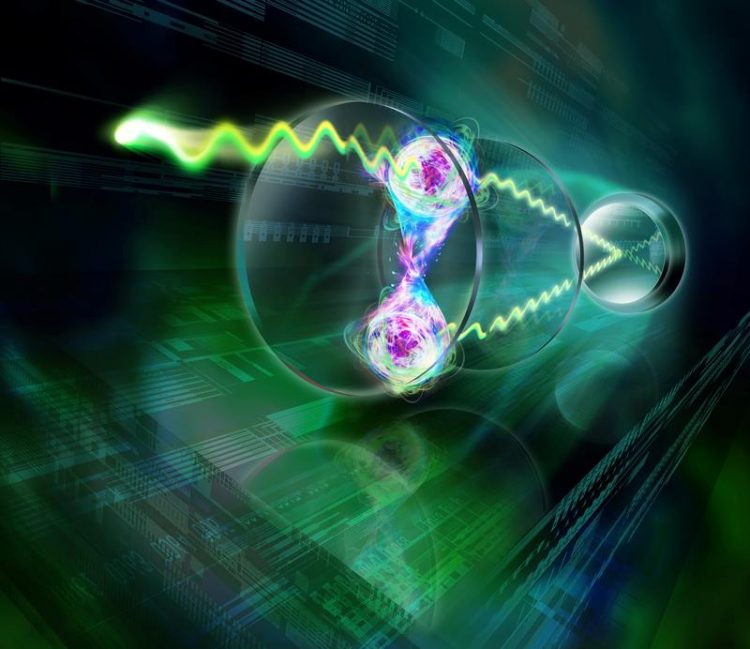Entangled atoms shine in unison

Physicists compared the photon interference produced by entangled and non-entangled barium atoms. IQOQI Innsbruck/Harald Ritsch
The age of quantum technology has long been heralded. Decades of research into the quantum world have led to the development of methods that make it possible today to exploit quantum properties specifically for technical applications.
The team led by the Innsbruck quantum computer pioneer Rainer Blatt controls individual atoms very precisely in experiments with ion traps. The deliberate entanglement of these quantum particles not only opens up the possibility of building a quantum computer, but also creates the basis for the measurement of physical properties with previously unknown precision.
The physicists have now succeeded for the first time in demonstrating fully-controlled free-space quantum interference of single photons emitted by a pair of effectively-separated entangled atoms.
Sensitive measurements
“Today, we can very precisely control the position and entanglement of particles and generate single photons as needed,” explains Gabriel Araneda from Rainer Blatt's team from the Department of Experimental Physics at the University of Innsbruck. “Together, this allows us to investigate the effects of entanglement in the collective atom-light interaction.”
The physicists at the University of Innsbruck compared the photon interference produced by entangled and non-entangled barium atoms. The measurements showed that these are qualitatively different. In fact, the measured difference of the interference fringes directly corresponds to the amount of entanglement in the atoms.
“In this way we can characterize the entanglement fully optically,” Gabriel Araneda emphasizes the significance of the experiment. The physicists were also able to demonstrate that the interference signal is highly sensitive to environmental factors at the location of the atoms. “We take advantage of this sensitivity and use the observed interference signal to measure magnetic field gradients,” says Araneda.
This technique may lead to the development of ultra-sensitive optical gradiometers. As the measured effect does not rely in the proximity of the atoms, these measurements could allow to precisely compare field strengths at separated locations, such as that of the Earth's magnetic or gravitational fields.
The work was published in the journal Physical Review Letters and was financially supported by the Austrian Science Fund FWF, the European Union and the Federation of Austrian Industries Tyrol, among others.
Publication: Interference of single photons emitted by entangled atoms in free space. Gabriel Araneda, Daniel B. Higginbottom, Lukáš Slodička, Yves Colombe, Rainer Blatt. Phys. Rev. Lett. 120, 193603 DOI: 10.1103/PhysRevLett.120.193603
Contact:
Gabriel Araneda
Department of Experimental Physics
University of Innsbruck
phone: +43 512 507 52472
email: Gabriel.Araneda-Machuca@uibk.ac.at
web: https://quantumoptics.at
Christian Flatz
Public Relations
University of Innsbruck
phone: +43 512 507 32022
email: christian.flatz@uibk.ac.at
web: https://www.uibk.ac.at
https://doi.org/10.1103/PhysRevLett.120.193603 – Interference of single photons emitted by entangled atoms in free space. Gabriel Araneda, Daniel B. Higginbottom, Lukáš Slodička, Yves Colombe, Rainer Blatt. Phys. Rev. Lett. 120, 193603
https://quantumoptics.at – Quantum Optics and Spectroscopy group
Media Contact
All latest news from the category: Physics and Astronomy
This area deals with the fundamental laws and building blocks of nature and how they interact, the properties and the behavior of matter, and research into space and time and their structures.
innovations-report provides in-depth reports and articles on subjects such as astrophysics, laser technologies, nuclear, quantum, particle and solid-state physics, nanotechnologies, planetary research and findings (Mars, Venus) and developments related to the Hubble Telescope.
Newest articles

First-of-its-kind study uses remote sensing to monitor plastic debris in rivers and lakes
Remote sensing creates a cost-effective solution to monitoring plastic pollution. A first-of-its-kind study from researchers at the University of Minnesota Twin Cities shows how remote sensing can help monitor and…

Laser-based artificial neuron mimics nerve cell functions at lightning speed
With a processing speed a billion times faster than nature, chip-based laser neuron could help advance AI tasks such as pattern recognition and sequence prediction. Researchers have developed a laser-based…

Optimising the processing of plastic waste
Just one look in the yellow bin reveals a colourful jumble of different types of plastic. However, the purer and more uniform plastic waste is, the easier it is to…


